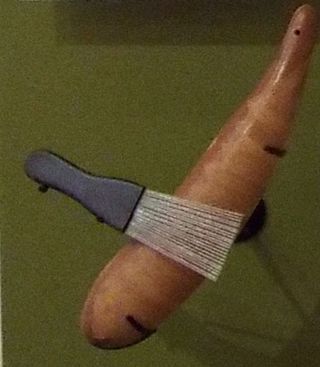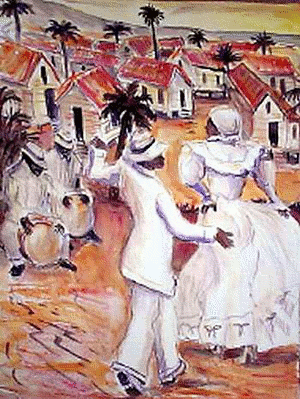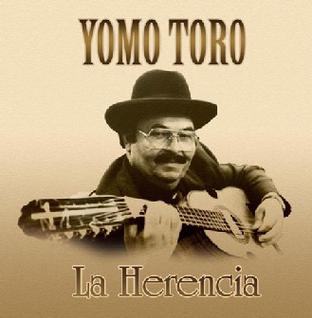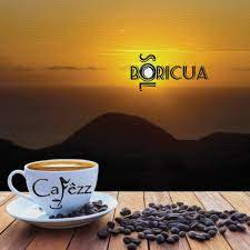
The güiro is a percussion instrument consisting of an open-ended, hollow gourd with parallel notches cut in one side. It is played by rubbing a stick or tines along the notches to produce a ratchet sound.
Danny Rivera is a singer and songwriter born in San Juan whose career spans nearly 50 years. He is well known in Puerto Rico for his political activism. In 2008, Rivera acquired Dominican Republic citizenship. After 12 years of work, Danny Rivera and Nelson González in 2014 finished work putting new life into the classical bolero - in Spanish. Rivera and González Hit the Heart of the Latin American Song Book on Obsesión

The Music of Puerto Rico has evolved as a heterogeneous and dynamic product of diverse cultural resources. The most conspicuous musical sources of Puerto Rico have primarily included African, Taino Indigenous, and European influences. Puerto Rican music culture today comprises a wide and rich variety of genres, ranging from essentially native genres such as bomba, jíbaro, seis, danza, and plena to more recent hybrid genres such as salsa, Latin trap and reggaeton. Broadly conceived, the realm of "Puerto Rican music" should naturally comprise the music culture of the millions of people of Puerto Rican descent who have lived in the United States, especially in New York City. Their music, from salsa to the boleros of Rafael Hernández, cannot be separated from the music culture of Puerto Rico itself.

Plena is a genre of music and dance native to Puerto Rico.

Bomba is an umbrella term that refers to a variety of musical styles and associated dances originating in Puerto Rico. It was developed by enslaved Africans and their descendants in sugar plantations along coastal towns, most notably Loiza, Mayagüez, Ponce, and San Juan, during the 17th century. It is the island's oldest musical tradition.

The Nuyorican movement is a cultural and intellectual movement involving poets, writers, musicians and artists who are Puerto Rican or of Puerto Rican descent, who live in or near New York City, and either call themselves or are known as Nuyoricans. It originated in the late 1960s and early 1970s in neighborhoods such as Loisaida, East Harlem, Williamsburg, and the South Bronx as a means to validate Puerto Rican experience in the United States, particularly for poor and working-class people who suffered from marginalization, ostracism, and discrimination.

Puerto Rican migration to Hawaii began when Puerto Rico's sugar industry was devastated by two hurricanes in 1899. The devastation caused a worldwide shortage in sugar and a huge demand for the product from Hawaii. Consequently, Hawaiian sugarcane plantation owners began to recruit the jobless, but experienced, laborers from Puerto Rico. In thirteen separate groups, 5883 Puerto Rican men, women and children traveled by ship, train then ship again to the islands of Hawaii to begin their new lives in the sugar plantations.

Jíbaro is a word used in Puerto Rico to refer to the countryside people who farm the land in a traditional way. The jíbaro is a self-subsistence farmer, and an iconic reflection of the Puerto Rican people. Traditional jíbaros were also farmer-salesmen who would grow enough crops to sell in the towns near their farms to purchase the bare necessities for their families, such as clothing.

A parranda is a Puerto Rican music tradition that takes place in Puerto Rico during the Christmas holiday season. Parrandas are social events that feature traditional Puerto Rican music, food, and drinks. The traditional events have been likened to Christmas caroling, but the contents of the songs are secular rather than religious. They are sometimes carried out in the evening, but most traditionally occur in the night, even into the wee hours of the morning. The songs sung are almost exclusively aguinaldos. In this tradition, people go to their friends' or relatives' homes "singing songs, eating pasteles and arroz con dulce, sipping coquito and picking up people along the way" who then join in to proceed to the next home.

MTV Unplugged is the name of the first live album by Puerto Rican singer Ricky Martin. It was released to the market in CD and DVD formats by Sony BMG Norte on November 7, 2006. It has been certified platinum and gold worldwide.

Víctor Guillermo "Yomo" Toro was a Puerto Rican left-handed guitarist and cuatro player. Known internationally as "The King of the Cuatro," Toro recorded over 150 albums throughout a 60-year career and worked extensively with Cuban legends Arsenio Rodríguez and Alfonso "El Panameño" Joseph; salsa artists Willie Colón, Héctor Lavoe and Rubén Blades; and artists from other music genres including Frankie Cutlass, Harry Belafonte, Paul Simon, Linda Ronstadt and David Byrne.

The seis is a type of Puerto Rican Jíbaro dance music closely associated with the décima. It originated in the latter half of the 17th century in the southern part of Spain. The seis is influenced by Spanish, African, and Taino cultures. The Arabian aspects come from Spain, where the Muslims or the Moors had ruled for over 700 years. Like other Jíbaro music, the seis is associated with Christmas, folkloric festivals, concursos de trovadores, and other large celebrations. The word means six, which may have come from the custom of having six couples perform the dance, though many more couples eventually became quite common. Men and women form separate lines down the hall or in an open place of beaten earth, one group facing the other. The lines would approach and cross each other and at prescribed intervals the dancers would tap out the rhythm with their feet.

William Richard Cumpiano is a builder of stringed musical instruments and is known for his writing and teaching of the art of luthiery. He has been involved in the preservation and understanding of the fading musical and musical craft traditions of his native Puerto Rico. Cumpiano was instrumental in the development of the first feature-length documentary about the cuatro and its music, Our Cuatro: The Puerto Ricans and Stringed Instruments, Volumes 1 and 2.

The Puerto Rican cuatro is the national instrument of Puerto Rico. It belongs to the lute family of string instruments, and is guitar-like in function, but with a shape closer to that of the violin. The word cuatro means "four", which was the total number of strings of the earliest Puerto Rican instrument known by the cuatro name.
Christian Nieves is a Puerto Rican cuatro player. Nieves is mostly known for been a performer in the American reality television series Q'Viva!: The Chosen, where his performance became famous for bringing singer Jennifer Lopez to tears who considered the melody very emotional.
Edwin Colón Zayas, is a Puerto Rican cuatro player from Puerto Rico. He joins a large number of Puerto Rican artists, "innovative tradition-bearing," who focus their talents in extolling the virtues of the Puerto Rican creole and Jíbaro way of life.

Chloe Auliʻi Cravalho is an American actress. She made her acting debut at the age of 16 as the voice of the title character in the Disney animated musical film Moana (2016). She went on to star in the NBC drama series Rise (2018), the Netflix drama film All Together Now (2020), the supernatural comedy Darby and the Dead (2022), the Amazon Prime Video sci-fi series The Power (2023), the Disney Channel animated series Hailey's On It!, and the 2024 film adaptation of the Mean Girls musical.
"How Far I'll Go" and its reprise are two musical numbers from Disney's 2016 animated musical feature film Moana. It was written by Lin-Manuel Miranda, with additional music and co-produced by Mark Mancina on its reprise. The song was performed in the film by American actress and singer Auliʻi Cravalho in her role as Moana. It was released along with the album on November 18, 2016. Canadian singer Alessia Cara also recorded the song for the Moana soundtrack. The song was nominated for Best Original Song at the 89th Academy Awards and Best Original Song at the 74th Golden Globe Awards and won the Grammy Award for Best Song Written for Visual Media at the 60th Annual Grammy Awards.

Released in 2016, Sol Boricua is Cafêzz' second album.

Los Pleneros de la 21 is a New York City-based drum and dance ensemble that has been active since 1983. They specialize in Afro-Puerto Rican bomba and plena music and related dance forms. In addition to performing, they run a community-based, not-for-profit educational company dedicated to preserving and celebrating Puerto Rican traditional culture and "fostering the legacy and history of Puerto Rican artistic traditions of African and Creole descent."















